After Qualcomm launched its ARM-based Snapdragon X series chipsets for Windows laptops, many dismissed Intel and the x86 architecture. However, with the launch of Lunar Lake processors, Intel seems to be back in the game and confident about its new chipsets. With Lunar Lake, Intel is touting massive improvement in efficiency, matching Snapdragon X Elite’s performance per watt figure. So, we have thoroughly compared Intel Lunar Lake vs Snapdragon X Elite using available data.
Intel Lunar Lake vs Snapdragon X Elite: CPU Performance
Let’s start with the CPU. Intel says its new CPU on Lunar Lake with eight cores (4x Lion Cove + 4x Skymont) offers 20% higher performance per watt compared to Qualcomm’s 12-core Snapdragon X Elite (X1E-80-100). Intel has derived the number based on the UL Procyon Office Productivity benchmark.

In another slide, Intel mentions that its top-end Lunar Lake SKU, Core Ultra 9 288V, delivers 7% faster performance than Snapdragon X Elite (X1E-80-100) in the Cinebench 2024 single-threaded test. The performance is similar in the Geekbench single-core test.
Intel seems to have avoided multi-threaded tests since Snapdragon X Elite packs 12 cores and all Lunar Lake SKUs feature 8 cores. We will bring you more numbers and comparisons once we get our hands on a laptop powered by the newly launched 8-core Snapdragon X Plus chipsets.
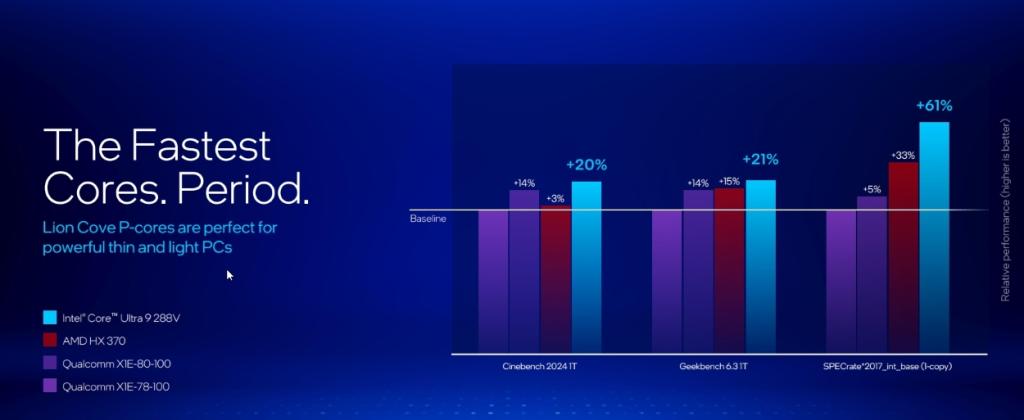
In another set of benchmarks, Intel touts that the Core Ultra 9 288V is tied with X Elite (X1E-80-100) in the Speedometer 3 test. In the PugetBench Photoshop benchmark, Lunar Lake offers 17% performance gains, while Intel’s new processor offers a whopping 92% performance improvement in the Handbrake test. It could be the case that Handbrake was running under Prism emulation on Snapdragon X Elite, but we can’t say for sure.
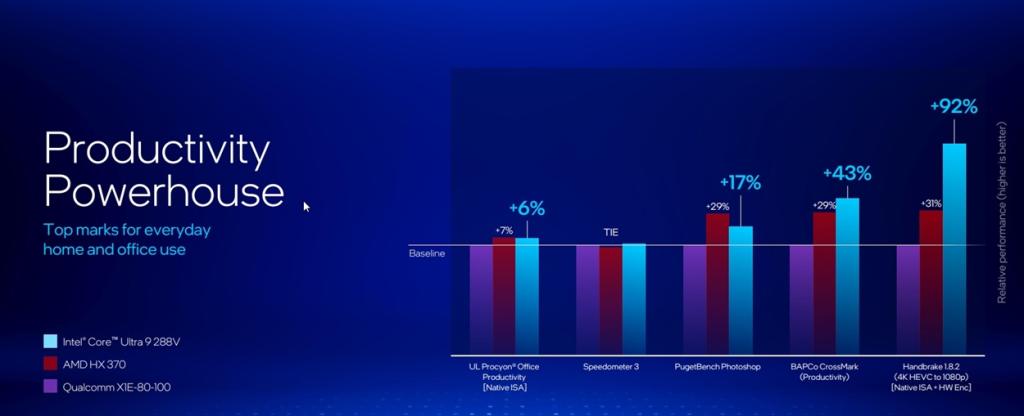
Overall, I would say the Lunar Lake CPU performance is nearly on par with Snapdragon X Elite’s Oryon CPU. Of course, with more cores on X Elite, multi-threaded performance would be much better on Qualcomm’s processor. However, I have tried to do an apples-to-apples comparison for your knowledge below comparing the 8-core SKUs of both processors.
Intel Lunar Lake vs Snapdragon X Elite: Geekbench Scores
In this Geekbench test, we have compared Lunar Lake’s lowest-end SKU (Core Ultra 5 228V) with the recently launched Snapdragon X Plus (X1P-46-100) since both feature 8 CPU cores.
Keep in mind, the Geekbench score for Snapdragon X Plus has been shared by Qualcomm running on a reference device (take it with a grain of salt). The actual score on retail units may change. Also, we have used the leaked score of Core Ultra 5 228V from Geekbench, which is running on a Lenovo laptop.
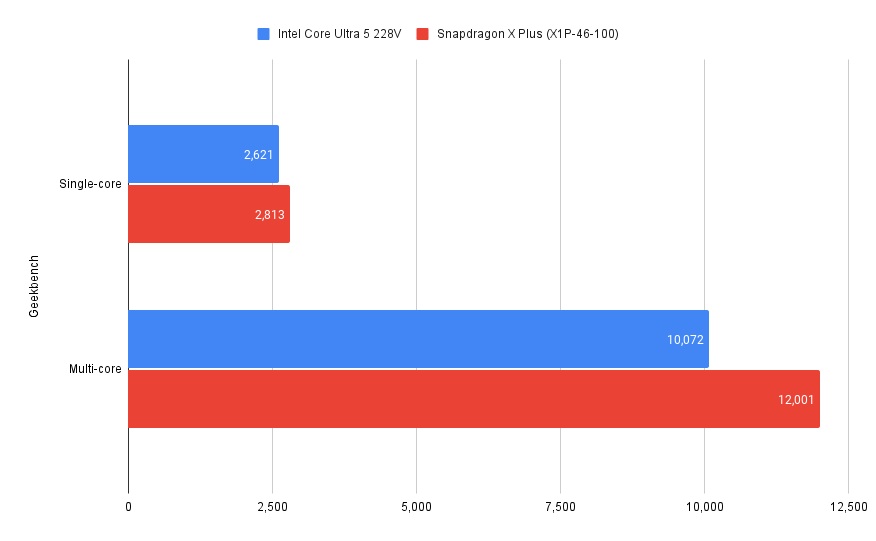
| Geekbench | Intel Core Ultra 5 228V | Snapdragon X Plus (X1P-46-100) |
|---|---|---|
| Single-core | 2,621 | 2,780 – 2,813 |
| Multi-core | 10,072 | 11,713 – 12,001 |
In the single-core test, the Snapdragon X Plus is about 7% faster than the Intel Core Ultra 5 228V, and the difference is 16% in multi-core scores, despite both packing the same number of CPU cores. Qualcomm’s Snapdragon X Plus has a standard frequency of 3.4GHz and can boost a single core up to 4.0GHz. Whereas, Lunar Lake’s efficiency core goes up to 3.5GHz and its performance core can clock up to 4.5GHz.
If we compare the top-end Lunar Lake SKU (8-core Core Ultra 9 288V) with Qualcomm’s flagship 12-core Snapdragon X Elite (X1E-84-100), the difference in single-core scores comes down to 3.6%. In terms of multi-core scores though, X Elite maintains a healthy lead of around 25% due to more cores.
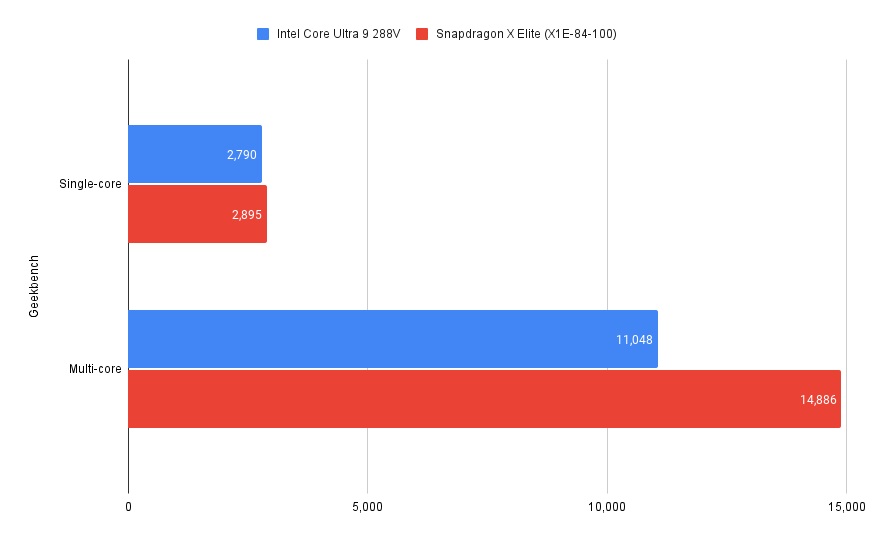
| Geekbench | Intel Core Ultra 9 288V | Snapdragon X Elite (X1E-84-100) |
|---|---|---|
| Single-core | 2,790 | 2,895 |
| Multi-core | 11,048 | 14,886 |
Remember that Intel is running Core Ultra 9 288V at 5.1GHz to match Snapdragon X Elite’s single-core performance, which is running at 4.2GHz. While it’s early to give a conclusive answer for which is better in the performance department, it appears that Intel is slightly behind Qualcomm’s Oryon CPU, despite making significant progress with Lunar Lake.
Intel Lunar Lake vs Snapdragon X Elite: Battery Life
As for battery life, Intel claims that Core Ultra 9 288V promises 14 hours of battery life on the UL Procyon Office Productivity benchmark. In the same test, the Snapdragon X Elite (X1E-78-100) delivers only 9.5 hours of battery backup. The test is done on a 75Whr battery pack from the same OEM.
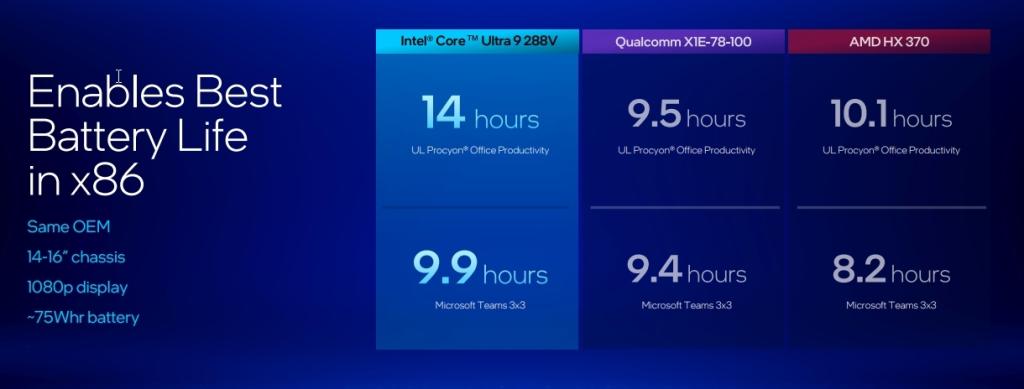
In fact, Dell XPS 13, which is now available with both Snapdragon X Elite (X1E-80-100) and Intel Core Ultra 7 256V, offers 27 hours of Netflix streaming on Qualcomm’s SoC and 26 hours on Intel Lunar Lake. In both tests, the screen brightness was set to 150 nits, and 1080p Netflix content was streamed.
It appears that Intel has made major strides in the battery life department. Moving to TSMC’s foundry has likely improved Lunar Lake’s efficiency. Since we don’t have a Lunar Lake laptop currently, we can’t make a conclusive judgment right away. But we will do a battery life comparison once we get a Lunar Lake laptop. And most importantly, we will test the standby battery when the device is put to sleep.
Intel Lunar Lake vs Snapdragon X Elite: GPU Performance
Coming to GPU performance, well, Intel has included a powerful 8-Xe2 core GPU and it decimates Snapdragon X Elite’s Adreno X1 GPU. Intel says its Xe2 GPU on Lunar Lake is 68% more powerful than the Adreno X1-85 GPU available on the top-end X1E-84-100 SKU of Snapdragon X Elite.
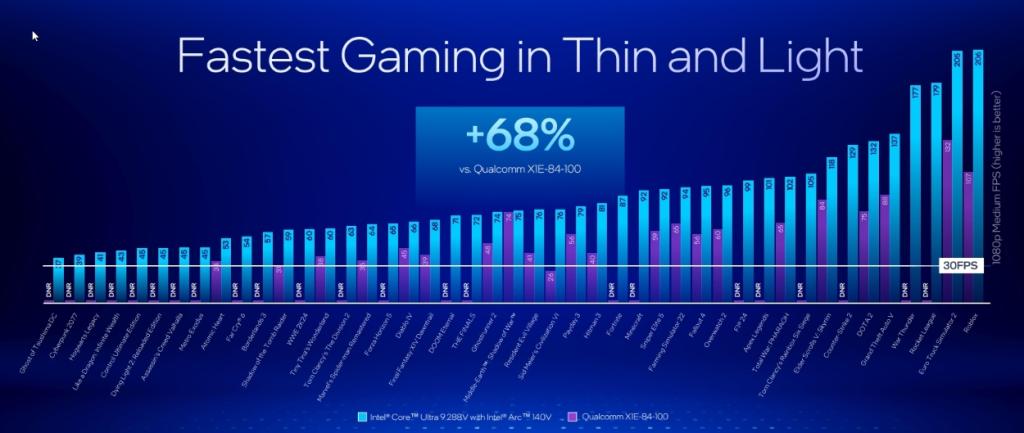
Not only that, Intel mocked Qualcomm as 23 Windows games didn’t run on the Snapdragon X platform due to incompatibility issues. On top of that, Lunar Lake’s GPU supports real-time Ray Tracing, which is not available on Snapdragon X Elite at all.

Even if we compare the lowest-end SKU of Lunar Lake with the top-end Snapdragon X Elite GPU, Intel beats Qualcomm in the Geekbench OpenCL test. Intel says that Lunar Lake has “World’s Best Built-in GPU” and it looks like Intel has significantly upped the game on the GPU front.
| Geekbench GPU | Intel Core Ultra 5 228V | Snapdragon X Elite (X1E-84-100) |
|---|---|---|
| OpenCL Score | 25,064 | 23,527 |
Intel Lunar Lake vs Snapdragon X Elite: NPU Performance
Intel has again delivered a breakthrough performance in the NPU department. It has designed a new NPU for Lunar Lake that can process AI workloads from 40 TOPS to 48 TOPS, depending on the SKU. Qualcomm’s Snapdragon X Elite delivers 45 TOPS across all its SKUs.
In the UL Procyon AI Computer Vision benchmark, Intel’s NPU scored 1,886 and 1,017 on INT8 and FP16 data types, respectively. In comparison, Snapdragon X Elite’s NPU scored 1,760 on INT8 and didn’t run on FP16 data type.
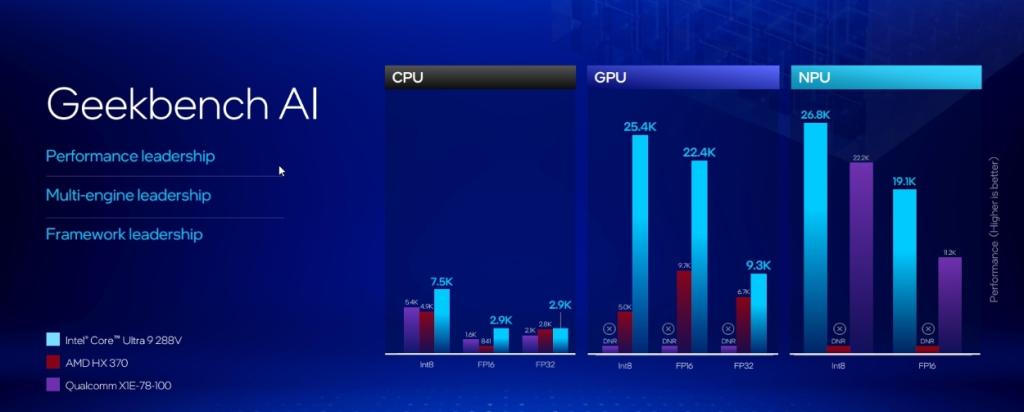
Finally, in the newly launched Geekbench AI benchmark app, Intel’s NPU performed better than Snapdragon X Elite’s NPU on both INT8 and FP16 data types. This goes on to show that Intel has indeed designed a powerful NPU and all new Lunar Lake laptops will be eligible for Copilot+ PC features with an update in November 2024.
Intel Lunar Lake vs Snapdragon X Elite: The Verdict
Although it’s pretty early to conclude, available Lunar Lake data suggests that Intel has proved that x86 architecture can be designed for efficiency. Moving to TSMC’s foundry, adding onboard memory, and putting all major units – CPU, GPU, and NPU – into a single Compute tile has resulted in a much more efficient chipset.
The Lunar Lake CPU is slightly behind Snapdragon X Elite’s Oryon CPU, but its integrated GPU is much more performant with Ray Tracing capability. And the NPU is also on par with Qualcomm’s Hexagon NPU. Not to mention, Intel has the compatibility advantage ensuring users don’t have to worry about running a certain app or game.
To conclude, the competition between different architectures is pretty exciting. I am stoked to get my hands on a Lunar Lake laptop so we can run various benchmarks on our end and check out the difference in battery life in real-world scenarios.
CMF Phone 1 Misses Out On The One Trick That Swayed Nothing Users
18 Best ‘Friends’ Episodes, Ranked
All Hades 2 Characters And Gods


